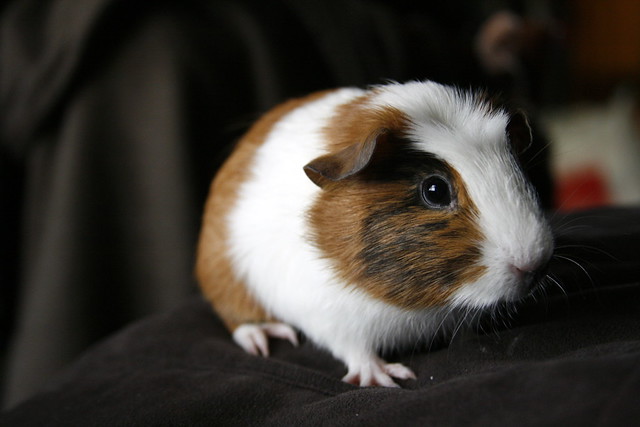So you've just brought your new guinea pig home from the shelter or pet store. And now, you're not entirely sure what to do. Let us help you get off to a good start with this Quick-Start Guinea Pig Owners' Guide.
First of all, if you've just returned from the shelter or pet store with a single pig, we strongly recommend that you turn right around and go back. Guinea pigs are social creatures and tend to do better when there are at least two pigs living together. Two females are a good combination. Two males can live together in harmony as long as they have been raised together. And while it is possible to introduce two grown males to each other, it does require patience and care. A male and a female are the very best combination, but of course one of them needs to be "fixed" in order to avoid a future in-cage population explosion.
 |
| Photo by j.reed |
Your first task is to choose a cage. Pet store cages tend to be too small to adequately house a single pig - not to mention multiple pigs. Use the following guidelines when choosing a guinea pig enclosure:
One guinea pig: 6-7 sq. ft.
Two guinea pigs: 7.5 sq. ft.
Three guinea pigs: 10.5 sq. ft.
If you cannot find one large enough at the pet store, you can always build your own cage or buy one online from a reputable cage seller. In recent years, C&C (Cubes and Coroplast ) cages have become quite popular because they provide a lot of cage for the money. Check out the resource box and the end of this article for a link to some online C&C guinea pig cage stores.
Place a nest box, a piece of PVC pipe or other enclosure inside the cage. Pigs like to hide out in cozy little places and providing a hiding place inside the cage will make your pigs feel happier and more secure.
Never place your pigs in an aquarium. Yes, some people do house their pigs in an aquarium, but it is very bad for their respiratory system. Toxic ammonia gas forms as your pigs urinate inside the enclosure. In a wire cage, there is adequate ventilation to carry this gas away. However, in an aquarium the ammonia gas is contained by the glass walls forcing your pigs to breathe it in all day long.
Fill the cage with bedding. Avoid cedar chips and cat litter made from clay. Both are very bad for your guinea pig's respiratory system. A litter made from recycled newspaper works very well. Also, many people have begun to line their cages with an absorbent material covered in fleece. The fleece allows liquids to wick through into the absorbent layer.
In general, Timothy hay is very good for you pigs. Your pigs can have it in virtually unlimited quantities. Alfalfa hay should be given much more sparingly. Alfalfa hay is richer and will cause your pigs to gain excessive weight.
While, commercial pellets are fine for your guinea pigs, however, they are also very rich and should be given in small quantities as a supplement to the main diet which should consist mostly of fresh vegetables and fruits. Only vegetables with rich dark colors should be chosen. Iceberg lettuce should never be fed to your pigs; it is mostly empty calories with little nutritional value.
Don't forget to install a water bottle in your pig's cage. Water dishes do not work well - as pigs tend to tip them over.
Above all, don't panic. Guinea pigs are wonderful animals and do not require an excessive amount of care. Remember that guinea pigs do better in pairs or groups than living alone. Be sure to provide adequate living space. C&C cages are a popular choice nowadays because they do provide a lot of room for a reasonable price. Provide a comfortable hiding place for your pigs - many nest boxes are available for guinea pigs. An upside-down small cardboard box works well too (although guinea pigs like to chew so you may have to replace it often). Feed your pig mostly deep-colored fresh veggies and provide a water bottle. That's all you need to get started. To learn more, pick up a good guinea pig reference guide - see the resource box at the end of this article for a link to a couple quality guinea pig care guides.
About the Author: We here at Blue Stone Commerce are pet owners as well as pet cage sellers. Visit Our Website http://www.BlueStoneCages.com for lots more info on guinea pigs and guinea pig cages. Be sure to Claim Your FREE BONUS GIFT available on the front page. Follow Us on Twitter: http://twitter.com/guineapig9 Source: www.isnare.com |

No comments:
Post a Comment